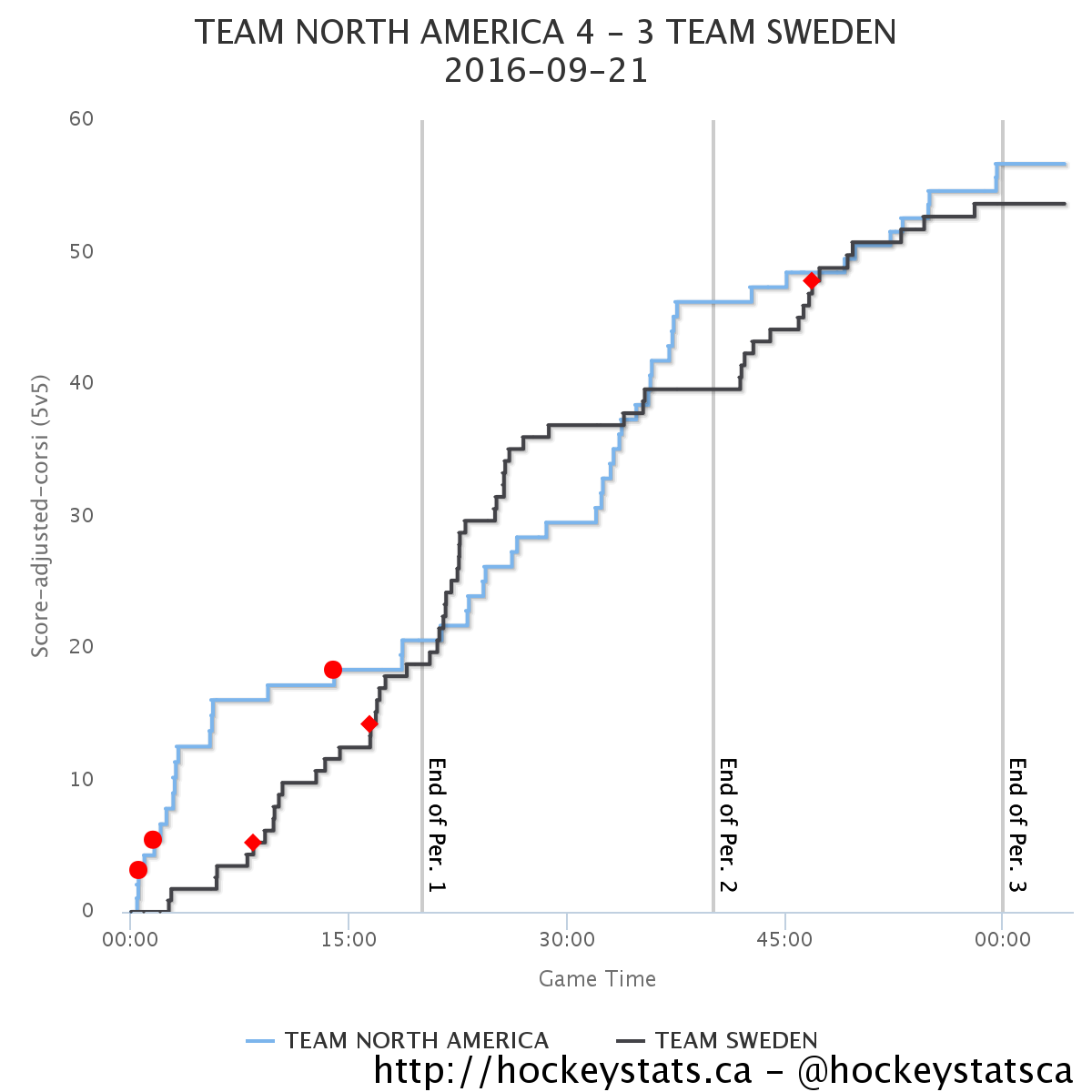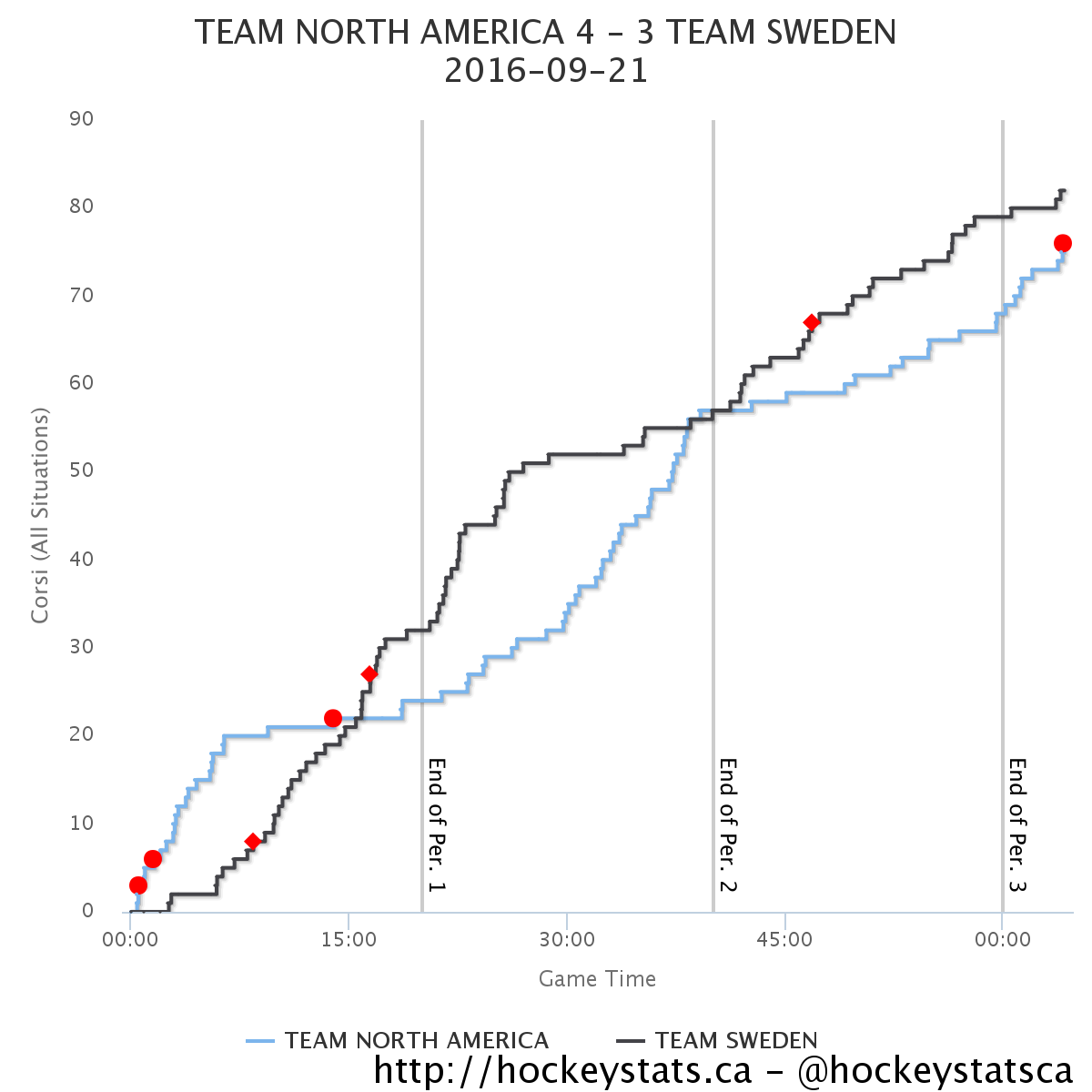Sweden in their beautiful blue jerseys and Team North America in their less than stunning whites took the ice today to a lot of cheers for a certain member of North America but much louder cheers for the Swedes. It seemed like Toronto had been invaded by Swedish fans.
It was a three anthem game, and it was amazing to hear two of them sung happily by the crowd. Sorry, America, we know all the words, us Canadians and the Swedes, we just weren't feeling it. To be honest, no one was feeling any of them much. It seemed too early in the day for the crowd to be pumped up much.
First Period
North America was pumped up just fine.
The first five minutes of play was a wild affair which saw Connor McDavid get an offensive rush going immediately. Then he got a second one which ended in a goal (more on that in a second), and then there was a penalty shot because Erik Karlsson was too slow to defend against Johnny Gaudreau without grabbing him.
Gaudreau looked really nervous and hesitant on the penalty shot, and Henrik Lundqvist had him easy. Remember that, it will be important later.
Next at 1:35 in (yes, we haven't hit the two minute mark yet), Vincent Trocheck scored. Shortly after, Karlsson got called again for holding on Gaudreau. Karlsson was simply overwhelmed by his speed. This time it was only a power play to North America, but that was a gift call from the official. The Swedes killed it easily with a very conservative penalty kill, almost Finnish in its perfection.
This is the five on five chart for the game, and you can see the nearly flat line that begins for North America at that point, about three minutes in.

The Swedes got one of three power plays in the period right after, and they faced a very un-Finnish hyper aggressive penalty kill from North America. The Swedes failed to score on all three, but the entire nature of the game had changed.
McDavid and Gaudreau were on the bench, the Swedes got to play the Sedins and Loui Eriksson extensively, and Gibson had to work hard.
Gibson did not look good.
Filip Forsberg got the Swedes on the board, and Gibson was flailing, swimming, making snow angels, and he looked spooked and unhappy.
And the period was barely half over!
Gaudreau got a breakaway chance, one of four faced down by Lundqvist in the first period, and suddenly the nerves were gone, and it was in, no problem. North America had their two-goal lead back.
They'd had a lead against Russia too.
Nicklas Backstrom got one back to make it 3-2 on a goal that came just as another of the North American penalties expired. The shot tipped in off Morgan Rielly's skate, but Gibson was beat stone cold, totally committed to the wrong side of the net.
The opening of the first period was beyond intense, and the Swedes are known to play a slow and easy start to games, politely waiting to see what their opponents want to do, and it cost them this time.
But North America proved, when they flatlined, when they started taking a lot of chasing the play type of penalties, that they are missing something in their games as individuals and as a group.
It's like their configuration files don't have the defaults set in them. When it all starts to go wrong, and the guys they were making fools of respond with calm certainty, they had no idea what to do. They slowed down and had to think about it, or they reacted with panic.
Some of that is unfamiliar linemates. Team Canada showed signs of that in their win over the USA, but some of it is the price of youth and inexperience.
At the end of the first period, even as McDavid missed on a breakaway chance on Lundqvist, it was clear that those two players were the elite talents on the ice, head and shoulders over everyone else.
Amongst the mere mortals there were some very impressive displays of skill on both sides of the ice, but nothing can match Auston Matthews and the opening goal of the game.
I heard angels sing. Fall on you knees....
Second Period
In case you want proof that Lundqvist is the King of the crease and was on his game today, goals against notwithstanding, here's the all situations chart. Note the early Swedish surge, as the North American confusion held, and then, the settling and relentless onslaught of the North American team through the rest of the second period.

There were no goals in the second. And that's because Lundqvist put on a clinic.
Gibson did not. He looked like Pekka Rinne out there, flailing around, sitting more than standing, flat on his back more than up on his knees. He got through it, but no one would call it good.
As the tide turned, the Swedes brought out their two counter punching lines, and they countered effectively. They played tight, ultra-conservative hockey, and it looked like the latter half of their game against Finland where they held a one-goal lead with so little effort to add to it, the Canadian commentators were squirming in discomfort.
The Swedish game was a little too conservative.
No one wants to see that much of Marcus Kruger in any game, even when he is very, very effective. He was tasked with shutting down McDavid, and he did it well.
At the very end of the period, with fatigue wearing on everyone, Sweden proved they could do young and stupid as well as the next North American man. Oliver Ekman-Larsson took a very foolish penalty for a slash behind the play, and that meant the Swedes would start the third a man down.
Lundqvist was a joy to watch in this part of the game, and the comparison to Gibson was a harsh light to look at a young rookie goalie in. Lundqvist is such a master of positioning that he made saves in traffic without moving, so he seems like he isn't doing anything. He isn't. He's done it already while you were watching the puck.
Third Period
The Swedes effectively killed the penalty, and North America looked slow on the power play.
And then the Swedes carefully, and slowly, turned the screw. They upped the offence a little, playing Karlsson with Hedman sometimes, they got more chances from their third line. Only Gibson settling down and playing well enough kept the score at 3-2.
But the Swedes were relentlessly turning their counter punching to punching. If they thought they'd tire out the North Americans, that was hopeless. The 23 and under squad played every second on the ice like they had boundless energy and bottomless reserves.
But it worked. Eventually. Patrik Berglund, bought in as a third line replacement, redirected a Karlsson shot after he had put on a clinic on how to dominate from the blueline.
The game was tied. A tie meant the Swedes were into the playoffs, and they showed just how you run down a clock without the more obvious tactics usually employed in the NHL.
Trocheck helped with an as young and foolish a penalty as Ekman-Larsson's, and late in the game McDavid took a strange penalty that likely should have been one to each side, but the Swedes put on a clock eating display of Swedish passing practice and contained the aggressive penalty kill of the North Americans, and that left only a few minutes to kill.
They had their tie game with no problem. North America never pulled Gibson, so they were content to go the lower risk option too.
Overtime
There are two NHL players who are overwhelmingly good at three-on-three hockey: Karlsson and Gostisbehere.
While Gostisbehere had been excellent in this game, Rielly was better, and he got the call for North America at first.
But Karlsson had the Sedins out there, and they showed how it was done. And it was the best, most entertaining overtime every played on NHL ice.
Complain about 3 on 3 OT again. I dare you.
— Garret Sparks (@GSparks40) 21 September 2016
Both sides made changes, cycled through the lineups, they traded chances, and Gibson made the save of the game on Daniel Sedin...
And then the puck went the other way, and...
And the win? It gets North America only another chance. If Russia beats Finland tomorrow they are in and North America is out, so the last playoff spot is on the Russian sticks. Sweden played the tactical game, and got in on the strength of their first two wins plus the single point for overtime.
No matter what happens, we all win, because we got to see this team, and all the coaches and GMs in the NHL can ponder what it means that they played that well in the way that they did.




Comment Markdown
Inline Styles
Bold: **Text**
Italics: *Text*
Both: ***Text***
Strikethrough: ~~Text~~
Code: `Text` used as sarcasm font at PPP
Spoiler: !!Text!!